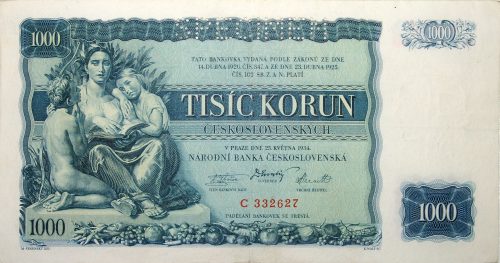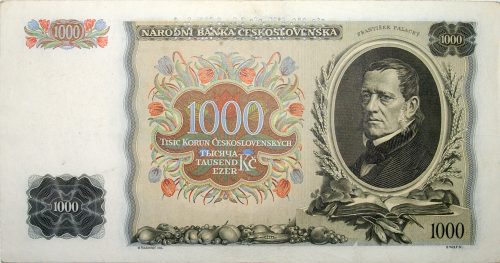P013
Paper, SPECIMEN, P-26s Crisp XF+
202 x 107 mm (8” x 4-3/16”)
HISTORY: František Palacký (1798‒1876) was a Czech historian and politician, called “Father of the Nation,” was the most influential person of the Czech National Revival. When Czechoslovakia became an independent nation in 1918, there was an urgent need to establish a new currency system, distinguished from the currencies of other newly formed countries suffering from high inflation following World War I. The following year, the new koruna (crown) was created, equal in value to the Austro-Hungarian krone. It served as the national currency of Czechoslovakia from April 10, 1919 to March 14, 1939.
The designer of this beautiful note was Max Švábinský (1873‒1962), a draughtsman, a painter, an illustrator, and a creator of stamps and banknotes (see also P035). He was the founder of a school of graphic arts and a professor of special graphic arts at the Academy in Prague.
OBVERSE: For this 1000-korun note, Švabinský has chosen the subject of a mother, the goddess Rozanica, seated, pausing as she reads to her son and daughter. Švábinský posed her in a revealing, gossamer blouse, her daughter resting in rapture upon her left shoulder. Kneeling to her right is her son, naked, leaning on an archer’s bow, gazing into her eyes as if asking a question. To his left, an eastern imperial eagle, common to Czechoslovakia, eyeing a sand lizard, slinking around the bottom corner and running into an abundant array of fruits and vegetables. An apparent blank space on the right is, in fact, the watermark profile of Rozanica, who represents the personification of creation, fertility, motherhood, and the embodiment of Earth’s bounty.
At the lower left is the artist’s name: “M · Švabinský Del ·” (Del, from the Latin delineavit, meaning “he drew it,” is generally inscribed next to the artist’s signature), and to the right the engraver: “K · Wolf SC ·” (Inc, Sculp, or SC, from the Latin incidit, meaning “he cut it,” synonymous with the Latin impressit, “he carved it.” These abbreviations refer to the individuals who engraved the master plate.)
REVERSE: A masterful cameo portrait of František Palacký dominates this 1000-korun note, framed by stalks of wheat. An open book rests at the base with a feathered quill emerging from beneath. In keeping with the theme of abundance, an ear of corn shares space with a row of fresh fruit, above which a wonderful bouquet of flowers is displayed.



